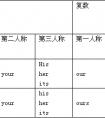改错题。1. Each of the students in our class have an English-Chinese dictionary. 2. We don’t go to school in Sunday. What about you? 3. Sometimes we pract-七年级英语
I caught her by the right hand. 我抓住她的右手。
比较:她拍了拍那男孩的头。
She patted the boy on his head. (误,本结构中身体部位或衣着前不用one's)
She patted the boy on the head. (正)
16 用在逢十的复数数词前,表示年代,也指人的大约岁数
例:The war broke out in the forties. 那场战争发生在40年代。
He went abroad in the 1980s. 他在20世纪80年代出国的。
The old man is in the seventies. 老人大约七十几岁。
17 用在表示自然现象的名词前
这类名词有:
the rain 雨,the wind风, the fog雾,the snow雪, the air空气, the storm风暴,the snowstorm 暴风雪
例:Don't stand in the rain. 不要站在雨中。
The wind blew down the trees. 风把树刮倒了。
The ship sank in the storm. 船在风暴中沉没了。
The rain has cleaned the air. 下雨净洁了空气。
The fog was so thick that we couldn't see the top of the hill. 雾很大,我们看不见山顶。
提示
a 这类名词前有形容词修饰时,可用不定冠词,表示“一场,一阵,一种”
例:A cold wind is blowing from the north. 冷风从北方吹来。
There was a heavy rain last night. 昨晚下了一场大雨。
A heavy snow is falling outside. 外面正下着大雪。
b 这类名词表示一般物质时,不用冠词。
例:Rain falls in summer; snow falls in winter. 夏天下雨,冬天下雪。
Man can't live without air. 没有空气人不能活。
18 与复数名词连用,指整个群体
例: They are the teachers of this school.指全体教师)
They are teachers of this school.(指部分教师)
19 表示所有,相当于物主代词,用在表示身体部位的名词前
She caught me by the arm…… 她抓住了我的手臂。
20 用在某些习惯用语中
例:
in the morning 在上午
in the evening 在晚上
in the field 在田野里
in the country 在乡间
in the sun 在阳光下
in the distance 在远处
on the right 在右边
by the way 顺便说一下
in the front of 在前部
in the daytime 白天
go to the concert 去听音乐会
at (/in) the beginning 开始
at the moment 当时,此刻
all the year round 一年到头
go to the cinema 去看电影
go to the theatre 去看戏
at the weekend 周末in the afternoon 在下午
in the night 在夜里
in the sky 在空中
in the dark 在暗处
in the rain 在雨中
in the shade 在阴凉处
on the left 在左边
all the time 始终
in the middle of 在中间
on the way home 回家途中
all the same 依然
on the whole 总之
at the same time 同时
on the plane 在飞机上
in the year 2008 在2008年
the other day 前几天
at the bottom of 在……底部
in the end 终于
on the one hand, on the other hand 一方面,另一方面
提示:
下面几个短语前不加定冠词:
例:at dawn 在黎明
at night 在晚上
at noon 在正午
at dusk 在黄昏
the的固定用法:
一、在表示方位和方向的名词前面,一般要加the。如:
The sun rises in the east and sets in the west.
二、在乐器名称前面要加the。如:play the piano。
三、在形容词最高级或序数词之前一定要加the。如:the first,the best,等等。
四、表示全体总称(泛指)。
名词或者形容词前加the,可表示该事物的全体,如:the poor指“穷人”。
这一用法本身并不难,难在这一全体所表示的“数”上。
在一开始所举的例子中,the lion指的就是这“一”类,表示的是单数的概念。
但在下面这个例子中,the old又用单形表示了复数概念。
The old are apt to catch cold.
五、另外,定冠词the在固定词组中出现,需要多加注意,逐渐积累。
如:to tell the truth, to go to the theatre, to keep the peace, with the exception of, in the morning……
定冠词用法顺口溜:
特指双熟悉,上文已提及;
世上独无二,序数最高级;
某些专有名,习语及乐器。
注:定冠词常用于以下几种情况:
①“特指”某个或某些人或物前。例如:
The books on the desk are mine.书桌上的书是我的。
“双熟悉”指谈话双方都熟悉的人或事物前。例如:
Where is the teacher?老师在哪里?
②上文已经提到的人或事物前。例如:
I can see a cat.The cat is Lucy's.我能看见一只猫。那只猫是露茜的。
③世界上独一无二的事物前。例如:
The earth goes around the sun.地球围绕太阳转。
④序数词或形容词最高级前。例如:
September is the ninth month of the year.九月是一年中的第九个月。
Mike is the tallest of the three boys.迈克是三个男孩中最高的一个。
⑤由普通名词构成的专有名词前。例如:
the Great Wall(长城),
the People's Park(人民公园)等。
⑥一些习惯用语中或乐器前。例如:
in the day(在白天),
play the piano(弹钢琴)等。
不用冠词的几种情况:
下列情况应免冠,代词限定名词前;
专有名词不可数,学科球类三餐饭;
复数名词表泛指,两节星期月份前;
颜色语种和国名,称呼习语及头衔。
注:
①名词前已有作定语用的this,that,these,those,my,your,his,her,our,their,some等限定词。例如:
this eraser,her pencil-box,some boxes,these women等。
②泛指的不可数名词前一般不用冠词。例如:
meat,rice,water,bread,tea,milk,juice等。
③表示学科的名词前一般不用冠词。例如:
Chinese,maths,English,physics,history等。
④在三餐饭和球类运动前一般不用冠词。例如:
have breakfast/lunch/supper,play basketball/football/volleyball/table tennis/tennis/pingpong等。
⑤复数名词表示泛指时不用冠词。例如:
His parents are both workers.他父母都是工人。
The people in the room are doctors.房间里那些人是医生。
⑥季节、节日、星期、月份前不用冠词。例如:
autumn,winter,Teachers' Day,Children's Day,Sunday,Wednesday,February,October等。
⑦表示颜色、语种和国家的名词前不用冠词。例如:
white,brown,French(法语),Japanese(日语),Australia,America(美国)等。
⑧表示称呼语的名词之前以及职务、头衔的名词后也跟有名词时不用冠词。例如:
What's wrong,Granny?老奶奶,怎么啦?
Doctor Green is a scientist.格林博士是位科学家。
考点名称:动名词
- 动名词:
如果一个动词加上了ing变成了名词,那么这个词称动名词。 动名词是一种兼有动词和名词特征的非限定动词。
它可以支配宾语,也能被副词修饰。
由于动名词是由动词变化而来,它仍保留着动词的某些特征,具有动词的某些变化形式,用以表达名词所不能表达的较为复杂的意念。
动名词的名词特征表现在它可在句子中当名词来用,作主语、宾语、表语、定语。 动名词的结构和形式:
动名词的否定结构:
动名词的否定结构由not 动名词组成。如:
Trying without success is better than not trying at all. 实验没有成功也比不实验好。
He hated himself for not having work hard. 他悔恨自己没有用功。
I’m sorry for not having telephoned you before. 很抱歉,没有早给你打电话。
He felt sorry for not having done the work well. 他为没有把工作做好感到难过。
I fancy it has done you a lot of good not going. 我看不去对你倒好了。
(not going 是动名词一般式的否定形式)
There is no denying the fact that he si diligent.
(no denying 也是动名词一般式的否定)动名词复合结构:
通常情况下,动名词的逻辑主语为谓语动词的主语。如果动名词动作的发出者不失谓语动的主语时,则需要有自己的逻辑主语物主代词或名词所有格加动名词就构成了动名词的复合结构,这种结构在句中可以作主语,宾语等。
(1)逻辑主语是有生命的名词作主语时,必须用名词或代词所有格,作宾语时(尤其在口语中),也可用名词普通个或人称代词宾格。如:
Do you think my going there will be of any help?
你看我去会有什么帮助吗?(宾语)
The student’s knowing English well helps him in learning French.
这位学生通晓英语对他学法语很有帮助。(主语)
Do you mind my(me) smoking ? 你介意我抽烟吗?(宾语)
They insist on Mary’s (Mary) going with them there.
他们坚持要玛丽跟他们一起去那儿。(介词宾语)
(2)逻辑主语是无生命名词是,通常只用名词普通格。如:
Do you hear the rain pattering on the roof?
你听见雨点打在屋顶上了吗?
Is there any hope of our team winning the match ?
- 最新内容
- 相关内容
- 网友推荐
- 图文推荐
| [家长教育] 孩子为什么会和父母感情疏离? (2019-07-14) |
| [教师分享] 给远方姐姐的一封信 (2018-11-07) |
| [教师分享] 伸缩门 (2018-11-07) |
| [教师分享] 回家乡 (2018-11-07) |
| [教师分享] 是风味也是人间 (2018-11-07) |
| [教师分享] 一句格言的启示 (2018-11-07) |
| [教师分享] 无规矩不成方圆 (2018-11-07) |
| [教师分享] 第十届全国教育名家论坛有感(二) (2018-11-07) |
| [教师分享] 贪玩的小狗 (2018-11-07) |
| [教师分享] 未命名文章 (2018-11-07) |

![The jeans_____ fit for me, maybe, the pair of jeans _____fitter for me.[ ]A.are; are B.is; is C.is ;areD.are; is-八年级英语](http://www.00-edu.com/d/file/ks/4/2/xidongci/2020-01-05/small4952a8c67458a8ae95f5f8e3ea8b4bf91578154110.png)
![Here _____some flowers.[ ]A.isB.areC.amD./-七年级英语](http://www.00-edu.com/d/file/ks/4/2/xidongci/2020-01-04/smallef3acfcb329d087ede3710c354ecc9151578152853.png)
![The price of the socks_____ 10 yuan. [ ]A. are B. is C. does D. can -七年级英语](http://www.00-edu.com/d/file/ks/4/2/xidongci/2020-01-04/small6e5d2db89e73d5a89d7deae9143a225a1578153319.png)


